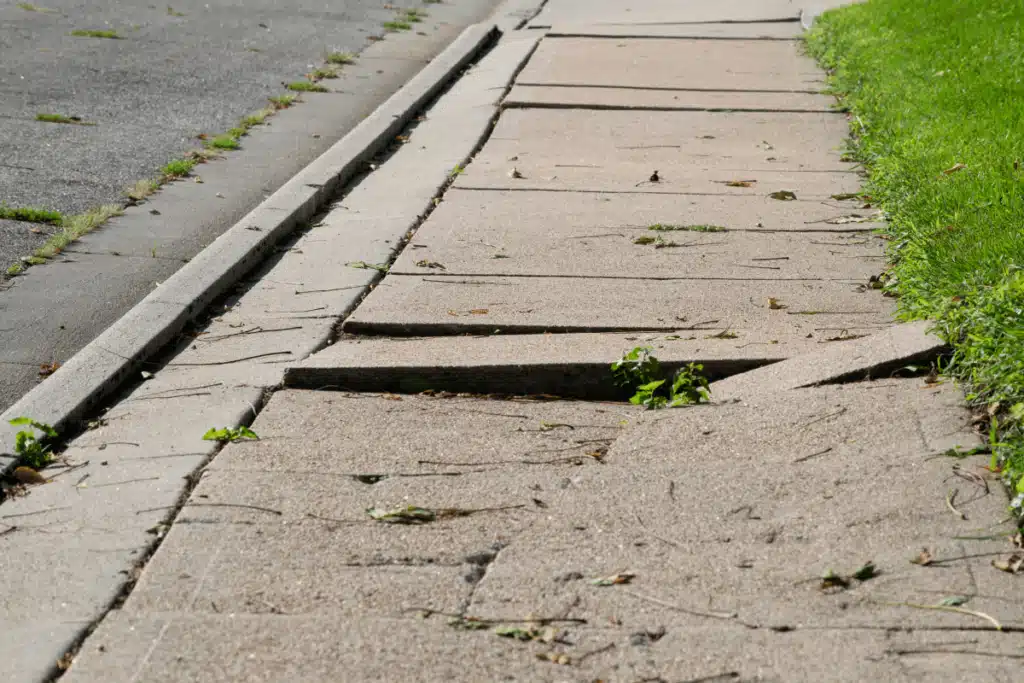Can You Sue the City for Falling on the Sidewalk?
- In California, you can sue the city for injuries caused by falling on a public sidewalk.
- The duty to maintain sidewalks safely usually lies with the local government or the adjacent property owner.
- You must prove that the sidewalk was dangerously maintained and this condition caused your injury.
- You must prove that the city knew (or should have known) about it but failed to repair it.
- There’s a six-month time limit from the date of injury to file a claim against the government in California.
If you’ve been injured from falling on a public sidewalk in California, you may have a valid slip and fall injury claim. A sidewalk marred by cracks, uneven surfaces, or ice puts pedestrians at risk of falling and suffering physical injuries.
Depending on the location of the sidewalk, the duty to safely maintain it rests either with the local government or the property owner. Generally, if the government maintains the sidewalk on which you fell and fails to keep it in a safe condition, you may seek to hold it responsible for your injuries.
- Can You Sue the City for Falling on the Sidewalk?
- Who Else Can Be Responsible for a Sidewalk Accident?
- What Causes Slip, Trip, and Fall Accidents on Sidewalks?
- What To Do After Falling on a Sidewalk
- Damages You Can Recover for Injuries Caused by Defective Sidewalks
- Time Limit for a Claim Against the Government in California
- How Can Cutter Law Help?
- Frequently Asked Questions
Can You Sue the City for Falling on the Sidewalk?
Yes, you can sue the city if it owns the sidewalk. If you can prove that the city was responsible for your fall because it neglected to keep the sidewalk in good condition, then you may be able to hold the government liable for damages. You must establish the following to prove your case:
- The sidewalk was in a dangerous condition.
- The sidewalk’s condition was the cause of your fall and injury.
- The city knew or should have known that the sidewalk was in a dangerous condition.
- The city had sufficient time to repair the sidewalk but failed to take action, or a city employee’s mistake or carelessness led to sidewalk hazards.
Who Else Can Be Responsible for a Sidewalk Accident?
Depending on local laws, property owners may be liable for a sidewalk accident. California law makes property owners responsible for maintaining public sidewalks adjacent to their property. However, the municipality remains liable for an accident on a public sidewalk unless it has enacted an ordinance specifically addressing liability.
If the owner of the property fronting the sidewalk is a local government entity, that public entity will be responsible. For example, if you’re a parent whose child slipped on school property, the educational institution may be responsible. If your child was injured due to dangerous conditions at their school, you may be able to file a claim against a school district.

What Causes Slip, Trip, and Fall Accidents on Sidewalks?
There are various causes of sidewalk slip, trip, and fall accidents, including the following:
- Accumulation of rainwater, ice, or snow on the sidewalk
- Damaged or uneven surfaces, such as holes or large cracks
- Individuals not paying proper attention while walking
- Dim or inadequate lighting
- Dangerous debris or waste materials littering the sidewalk
What To Do After Falling on a Sidewalk
Falling on a sidewalk can be painful and embarrassing. Here are some things to do after your fall:
- Seek medical help: Even if you think your injuries are minor, visiting a doctor and getting a medical report is important. A medical report will prove your injuries if you decide to sue the at-fault party.
- Get picture evidence: Take photos of your injuries and the sidewalk’s condition. This will help show that the condition caused the injury.
- Collect witness contact information: If there are people who witnessed the fall, speak with them and get their contact information.
- Report the accident: Inform the property owner or local authority of your accident so the danger can be properly remedied.
- Don’t sign anything: The liable party or their insurance provider may try to close the matter quickly. They may offer you a settlement that is less than what you deserve. Don’t make any decisions before speaking with a slip-and-fall accident attorney.
- Keep records: Track all your hospital visits, expenses incurred because of your injuries, lost wages, and your emotional state after the fall.
- Speak with a lawyer: Consult a personal injury lawyer to understand your case and the next steps.
Damages You Can Recover for Injuries Caused by Defective Sidewalks
You can recover economic and non-economic damages if you’ve been injured in a sidewalk slip and fall due to someone else’s negligence. Here are some of the things you can seek compensation for the following:
- Medical bills such as future medical bills and rehabilitation costs
- Medical equipment and drug costs
- Property damage
- Lost wages
- Lost future income
- Pain and suffering
- Loss of consortium
- Emotional distress
Time Limit for a Claim Against the Government in California
You have six months from your injury date to file a claim against the government. Generally, claims against the government have a shorter statute of limitations than other personal injury claims.
How Can Cutter Law Help?
Determining who to hold responsible for a sidewalk accident may be difficult and generally depends on local laws. It is important to consult a lawyer to determine the party liable for your injuries. Our experienced lawyers at Cutter Law can help you determine who is responsible for negligence. We can also help you gather evidence of the city’s liability and file your claim on time.
Examples of slip, trip, and fall settlements for our clients include:
Attorneys Brooks and Margot Cutter obtained a $10 million settlement during jury selection for a trip and fall accident that resulted in major injuries.
Attorneys Brooks and Margot Cutter obtained a $350,000 for a client involved in a slip and fall accident in San Jose.
Frequently Asked Questions
Are Sidewalks Public Property?
Yes, sidewalks are generally public property.
Who Is Responsible for Sidewalk Maintenance?
The government and property owners are responsible for maintaining sidewalks. Local laws and the entity responsible for negligence determine who you can sue for your sidewalk accident.
How Much Can You Recover From the City for a Sidewalk Accident Claim?
The value of damages you can recover from a sidewalk lawsuit depends on many factors, including the severity of your injury and its impact on your life. Other factors include the cost of treating the injury and any belongings lost or broken in the sidewalk accident.
What Do You Need To Prove in Your Sidewalk Case?
To win your sidewalk injury lawsuit, you’ll need to prove each of the following:
- The defendant owned or had a duty to maintain the sidewalk.
- A hazardous condition or danger existed on the sidewalk.
- The defendant knew or should have known about this danger but failed to fix it.
- The owner’s actions or failure to act directly caused your injury.
- You’ve suffered damages.

You can sue for compensation if you were hurt falling down stairs, especially if your injuries are severe.

If you suffer injuries from a parking lot fall, you may be able to sue the owner if they knew or should have known about the condition.

Some claims may reach a pre-litigation settlement relatively quickly, while others may take years to resolve, especially if they proceed to trial.
